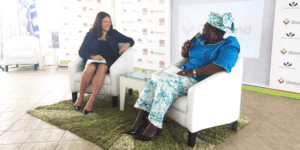Women’s World Banking celebrated the 10th anniversary of our signature Women in Leadership program in 2016. In marking this important milestone, we sought to examine the current state of gender-diverse leadership around the world to see how much the needle has moved in recent years and what remains to be done. How much progress are financial and other institutions making, not just in promoting women to leadership positions, but also in fostering an inclusive culture where women can thrive once in those posts? What obstacles still stand in the way? How can we and our partners address those challenges?
Credit Suisse’s Gender 3000 study demonstrates that gender-diverse boards and management show higher returns on equity, price/book valuations and stock prices. Data from Women’s World Banking’s network of financial institutions underscores these findings: organizations with more than 35% women board members, managers and staff show a higher Return on Assets (ROA) and have more women as clients. Yet, it is also evident that the growing awareness of the benefits of women’s leadership isn’t yet translating into noticeable changes at most organizations worldwide.
To examine the gender gap region by region, Women’s World Banking hosted roundtables in Africa, India and Southeast Asia on the local and cultural factors that may block women’s advancement. Participants included representatives from financial services, the financial inclusion sector, leadership and diversity space, government and academia.

Next, Women’s World Banking hosted a roundtable in Mumbai and partnered with Oliver Wyman to host our final roundtable in Singapore. In India, several factors present today may contribute to positive change including more globalized markets, a large talent gap and more women demanding good jobs. However, there is a long way to go to achieve gender parity. Many companies have a growing awareness of the business case for gender diversity but may feel that the case is not strong enough to counteract strong cultural norms. Others may want to change but do not know how to go about it. Participants suggested solutions that might speed change include educating women and men about the benefits of equality, ensuring that businesses disclose diversity statistics to spur public and peer pressure and encouraging women to be vocal about their ambitions.

In Singapore, the discussion focused on what gender parity meant personally to each of the participants and the barriers that remain to achieving it. One important element was the prevalence of biases, many of them unconscious: for example, seeing motherhood as a liability while fatherhood is not viewed that way. The discussion ended with specific steps that institutions can take to move towards parity and a call to action for participants to commit to the changes they can personally put in place in their respective contexts.
Participants in all three roundtables agreed that actions will not be effective in isolation. Businesses, academia, policymakers and activists all have a part to play. Moreover, intentional focus by senior leaders and clear accountability are key.
In organizations on the frontlines of advancing gender diversity, there is a need to go beyond the numbers game of simply recruiting more women. Because cultural context and organizational culture deeply influence women’s advancement there is no one-size-fits all approach. However, some consistent solutions that participants agree would advance diversity and foster inclusion emerged across the three discussions:
- Collecting and sharing gender-disaggregated data. Along with numerous studies published in the past few years that demonstrate the business case, reviewing internal data will spur more leaders and their institutions beyond awareness to action.
- Developing clear objectives for gender diversity that are actionable and measureable. Having goals in writing is not enough; management must be held accountable for them.
- Investing in training and leadership programs that build inclusive cultures and focus on mentoring and advocating for the advancement of women.
- Implementing flexible work conditions that support all Options such as shortened workdays, the ability to work from home and part-time hours enable women and men to balance their roles at home and in the workplace. It is important that the policies that support mothers and women do not exclude men. There is often a stigma attached to “women-” or “mother-” specific policies and men perceive them as irrelevant.
- Actively engage men at the national, institutional and family levels.
Our extensive experience conducting leadership training and organizational gender assessments for financial institutions around the world reinforces that these actions are critical for advancing women’s leadership. We also know they work best when implemented as part of the overall business strategy. While we clearly need an environment more welcoming of diversity and conducive of inclusion, Women’s World Banking also invests in current and future women leaders to give them the confidence, skills and vision to take their next step. As one high-ranking woman in Nigeria’s finance sector discussing her career journey said: “I wish I had known I was powerful.” Women leaders have the demonstrable potential to drive their institutions to greater success and to help them reach more women clients, but organizations must take intentional measures to ensure that women leaders are not just recruited, but also supported, throughout their leadership journey. To be truly successful however, they must be accompanied by a commitment to creating institutional and broader cultures of inclusion.




